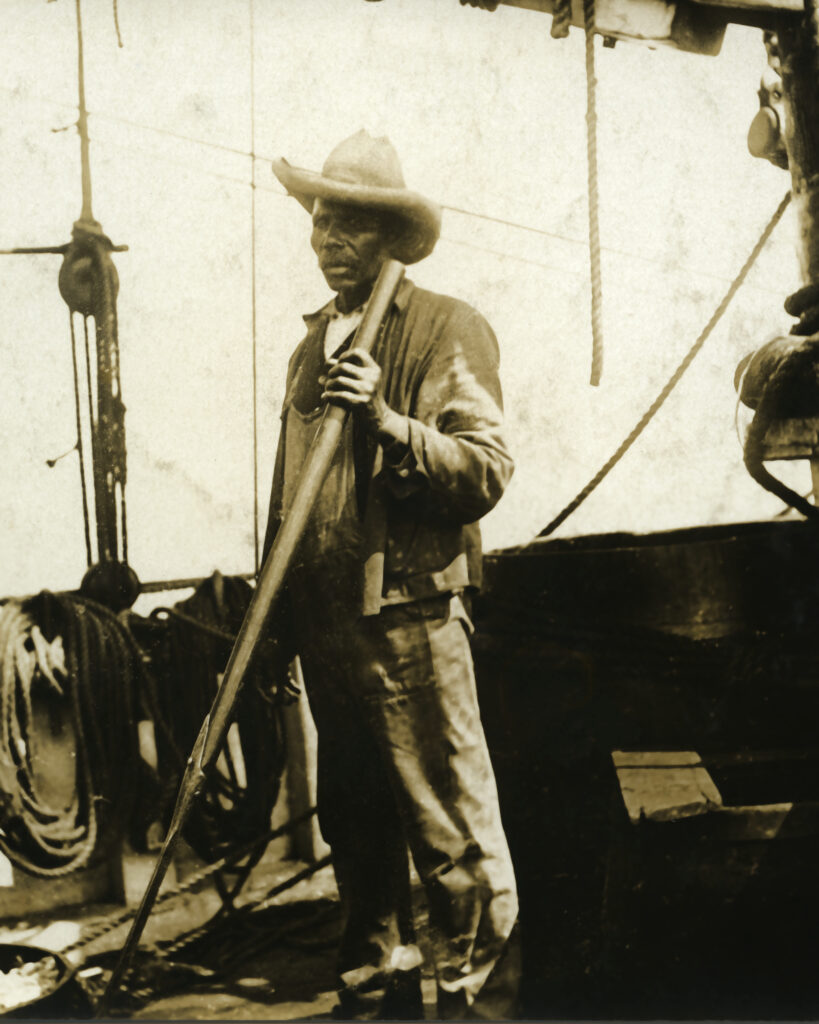2024 Frank C. Munson Institute of American Maritime Studies
For more than 60 years, the Frank C. Munson Institute at Mystic Seaport Museum has drawn graduate students, faculty, and independent scholars to its residential, five week-long summer programs in maritime studies. During the summer of 2024, the Munson Institute will offer two co-current courses focused on the American maritime experience. These courses will trace U.S. maritime heritage from before “America” to the present, exploring maritime communities, cultures, and industries through lecture, discussion, and independent research.
Applicants for the 2024 summer session may apply for one of the twelve fellowships. These positions are most particularly intended for junior faculty, graduate students, and advanced undergraduate students. Each of the resident fellowships, set to run from June 24 – July 26, will be supported with a $2,000 stipend, accommodations in museum-owned housing, and book purchases. We encourage applications from members of the region’s Native peoples and Black communities.
Admissions
Please complete the application form available here.
The application process:
1. Completed application form
2. Resume or C.V. (1-4 pages)
3. Application Essay (2-4 pages) – Essay should include applicant’s personal and academic interests, experiences and qualifications, reasons for applying, how the Institute relates to applicant’s personal or professional goals, and what applicant wants to get from the Institute.
4. Contact information for two references who are familiar with the applicant’s accomplishments or promise.
Graduate students and advanced undergraduate students are encouraged to apply.
The application deadline is March 8, 2024.
RESEARCH
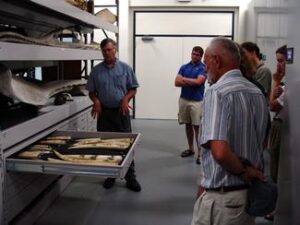 Collections – The collections at Mystic Seaport reflect the extraordinary scope and significance of America’s relationship with the sea and inland waterways. Housed in the Collections Research Center, the materials represent a wide variety of resources from manuscripts to fine art.
Collections – The collections at Mystic Seaport reflect the extraordinary scope and significance of America’s relationship with the sea and inland waterways. Housed in the Collections Research Center, the materials represent a wide variety of resources from manuscripts to fine art.
G.W. Blunt White Library – The library is one part of the Collections and Research Center at Mystic Seaport, where most of the museum’s holdings are housed. The research collection of the G. W. Blunt White Library is one of the most significant in the nation with over 70,000 volumes of books and periodicals, 2,000 rolls of microfilm, 1,000 ships registers, 1,000,000 manuscript pieces, 800 oral or video taped interviews, and 9,000 maps and charts.
Manuscripts – The 1,000,000 manuscript pieces include logbooks, journals, letters, diaries, business records, i.e. receipts, bills of lading, and Charter Parties, as well as government documents among other items. They can inform layers of study regarding all aspect of the maritime past.
Objects – Mystic Seaport’s collection is vast, and touches on nearly all aspects of the seafaring experience. Examples of materials in the collections include scrimshaw, ship’s portraits, ship models, half models, navigational instruments, fishing and whaling gear, clothing and other textiles, furniture, tools, period engines and much more.
Within the CRC building a researcher can also have access to 550 historic vessels, 100,000 sheets of ships’ plans, 1,500,000 feet of 1,000,000 feet for film and video, another 1,000,000 photograph images, and many of the 1,000,000 objects in the museum’s collection.
Munson Institute classes coordinate with the hours of operation with this unique maritime resource.
The Outdoor Museum
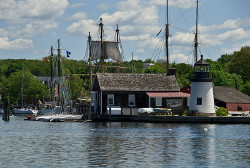
Most visitors to Mystic never see the collection storage areas or the library. They typically visit the outdoor museum with its 19 acres, 60 buildings, vessels afloat in the river, formal viewing galleries and one-of-a-kind Henry B. duPont Preservation Shipyard. These objects and their setting can be valuable research tools for the advanced scholar as well. Climbing aloft on a square-rigger, rowing a whaleboat, and chatting with a skilled blacksmith can offer a level of understanding that only direct contact with objects of the past being put to use can provide.
Students enrolled in the Munson Institute are allowed full access to these historical objects and skilled personnel.
Learn More
The 2024 Munson Institute will consist of two co-current courses focusing on American maritime history and an independent research project.
Exploring Maritime Histories
This lecture course studies the legacy of U.S. maritime heritage from before “America” to the present. Beginning with millennia-old Indigenous maritime cultures, this course traces U.S. maritime industries such as the slave trade, shipbuilding, whaling and fisheries, steam navigation and contemporary shipping. This course considers the disruption of colonialism to existing Indigenous maritime communities, the contributions of Black and Indigenous peoples to U.S. maritime industry, the American Revolution, the War of 1812, the Civil War, the new navy, American involvement in World Wars I and II, and globalization. It closes with a discussion of problems facing maritime communities.
Entwined: Freedom, Sovereignty and the Sea
This seminar studies in-depth African and Indigenous perspectives in maritime history and explores a reframing of that history which includes Black and Indigenous voices and histories as authoritative. Settler colonialism, Indigenous dispossession and enslavement, the slave trade, various elements of the slave institution in the region, and survivance and coastal and seaport communities will be explored through a maritime lens. Black and Indigenous life at sea, diaspora and spirituality will also be areas of focus.
Independent Research
Independent Research involves the preparation of a major research paper on a topic of your choice under the direction of the Institute Director and the senior Museum leadership, and making use of the resources of Mystic Seaport Museum’s collections. Participants must be qualified to work on a graduate level and to pursue research using primary documents and original sources.
Complete 2024 Munson Institute Syllabus Coming Soon.
LIFE IN MYSTIC
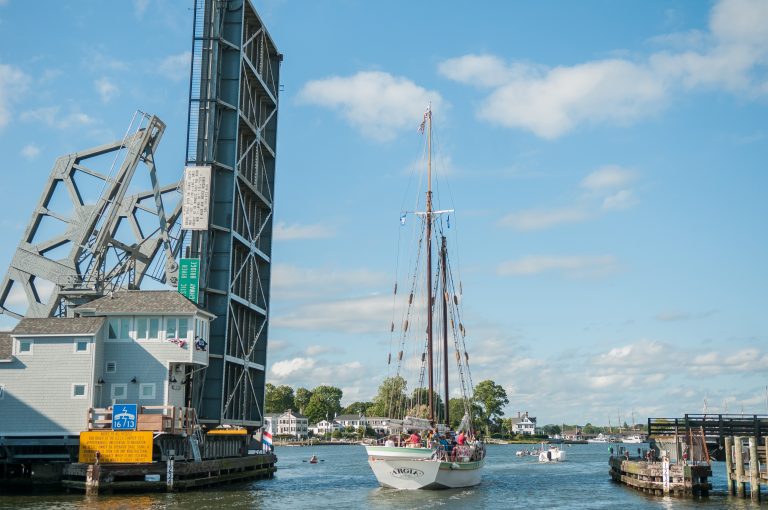
The bascule bridge in downtown Mystic is a local landmark.
The Town: Mystic, Connecticut, a picturesque community of nearly 10,000 residents, is a destination for tourists, history buffs, boaters, and coastal enthusiasts. As such it has a lively social scene during summer months when a brief walk to the downtown with its classic bascule drawbridge and many watering holes and eateries can offer a pleasant break from academics.
The name “Mystic” was derived from the Algonquian word Missituk, meaning great tidal river. This area was likely explored for the first time by Europeans in the 1600s by Captain Adrian Block, and settled by the English in 1654.
Mystic became a shipbuilding center for the whaling and fishing industries by the early 19th century. One Mystic-built ship of note, the 47-foot sloop Hero, carried Stonington native Captain Nathaniel B. Palmer to his discovery of Antarctica in 1820.
Ship building in Mystic continued through whaling and sealing days, and during the California Gold Rush, when the Mystic yards launched numerous ships, including the famed clipper ship David Crockett, whose average speed around Cape Horn to San Francisco was never equaled.
During the Civil War, shipbuilding efforts in Mystic peaked. Mystic produced a greater tonnage of ships than any other port of her size in the U.S. However, after the war, ship building in Mystic dwindled, and the boatyards were replaced with woolen mills. Other factories local to Mystic produced velvet, soap, and razors. By the early 20th century small boatyards embodied the legacy of Mystic’s glory days.
Mystic Seaport: Among the visitors to the museum every fall and spring is a small group of undergraduate students who have chosen to spend a semester of their college education at Mystic Seaport to study the sea with the Williams College-Mystic Seaport Program in Maritime Studies. This is the only undergraduate residential program at a museum in the United States, and was inspired by the Munson Institute itself.
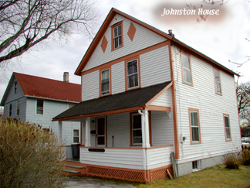 Housing: Each summer, up to ten Munson participants live in each of four historic houses adjacent to Mystic Seaport and the Mystic River. These nineteenth-century homes, where shipbuilders, mill workers and fishermen once lived, are equipped with high-speed internet connections, microwaves, furnishings, air-conditioning, and the comforts of a modern home. Rooms are either singles or doubles, while all other spaces in the house are shared in a cooperative approach to summer living. The Williams/Mystic students use these houses during the fall and spring, and summer-time neighbors could include museum studies interns and marine science researchers.
Housing: Each summer, up to ten Munson participants live in each of four historic houses adjacent to Mystic Seaport and the Mystic River. These nineteenth-century homes, where shipbuilders, mill workers and fishermen once lived, are equipped with high-speed internet connections, microwaves, furnishings, air-conditioning, and the comforts of a modern home. Rooms are either singles or doubles, while all other spaces in the house are shared in a cooperative approach to summer living. The Williams/Mystic students use these houses during the fall and spring, and summer-time neighbors could include museum studies interns and marine science researchers.
Local Attractions: The Mystic region is rich in cultural and natural attractions. Minutes away from Mystic Seaport is the Mystic Aquarium with its belugas, dolphins, touch tanks and more, as well as the Coogan Farm Nature & Heritage Center, with more than 10 miles of hiking trails. Downtown Mystic is a picturesque destination in its own right with shops, restaurants, riverside park and intriguing drawbridge. In nearby Groton one can find the USS Nautilus on display at the Submarine Force Museum next the active submarine base. Across the river New London has a working waterfront, a transportation hub, museums, historic homes, Connecticut College and the U.S. Coast Guard Academy. Twenty minutes in the other direction brings one to the open ocean beaches of Rhode Island. Within an hour one can also reach Hartford, New Haven or Providence, while another hour brings one to the threshold of Boston or New York City.
OPPORTUNITIES THROUGH THE MUNSON INSTITUTE
Applicants for 2024 Munson Institute with a specific research and writing project are encouraged to apply for the Paul Cuffe Memorial Fellowship for additional funding of up to $2400. Born in 1759 of African American and Native American parents, Paul Cuffe became a sea captain, shipowner, landowner, and respected community leader. Since 1989, the Museum’s Paul Cuffe Fellowship has provided funds to researchers from universities, colleges, and museums. The Fellowships are offered to encourage research that considers the participation of Native and African Americans in the nation’s maritime activities. Fellowships support research and writing, a portion of which should normally be carried out in the Mystic area. Paul Cuffe Memorial Fellows have two options:
- In addition to Munson Fellowship: Cuffe Memorial Fellow builds their research and writing into five weeks of residence and participates in University of Connecticut Summer graduate courses held at Mystic Seaport Museum’s Munson Institute.
- Stand-alone Cuffe Memorial Fellowship: supports research and writing, a portion of which should normally be carried out in the Mystic area. Please visit the Paul Cuffe Memorial Fellowship to apply.
The awards of up to $2,400 are made possible through the generosity of a local private foundation. If applying for the Cuffe Memorial Fellowship in addition to Munson Institute, please include Munson application materials, along with a full description of the proposed project, a preliminary bibliography, and brief project budget to be considered for this award. Fellowship recipients will be required to file a report on their research activities.
Journals for Publication
Munson Institute faculty also serves on the editorial boards of the several peer-reviewed journals that deal with maritime history and culture. Cuffe Fellows, Munson graduates, and researchers are encouraged to submit their final products to Mainsheet, The Northern Mariner, or The Nautilus.
Contact Us
For additional information, please email munson@mysticseaport.org
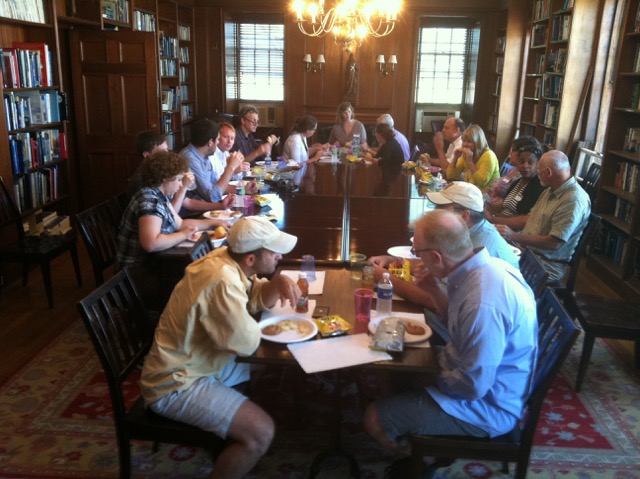
FACULTY AND SPEAKERS
2024 Munson Institute Faculty Bios Coming Soon.
Dr. Akeia de Barros Gomes is the Senior Curator of Maritime Social Histories at Mystic Seaport Museum. In that role, Dr. de Barros Gomes is responsible for working on curatorial projects of race, Indigenous histories, ethnicity, and diversity in New England’s maritime activities as it relates to the site and collections of Mystic Seaport Museum. She leads a multi-disciplinary team to examine the Museum’s and other regional collections to develop contemporary re-imaginings of people’s actions in the past and present, and translating that into content relevant to today’s social environment. She joined the Museum from the New Bedford Whaling Museum, where she was the Curator of Social History. Raised in Newport, RI, Dr. de Barros Gomes received a Ph.D. and M.A. in Anthropology with a focus in Archeology, from the University of Connecticut in 2008, and became a college professor before shifting to museum work.
Contact
Akeia de Barros Gomes, Ph.D.
Director, Munson Institute
860.572.5388
akeia.gomes@mysticseaport.org
| akeia.gomes@mysticseaport.org |
| akeia.gomes@mysticseaport.org |

